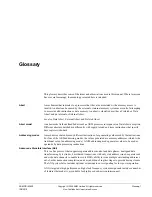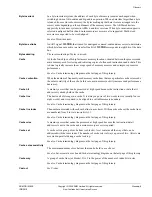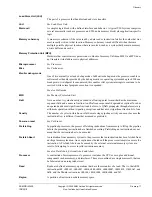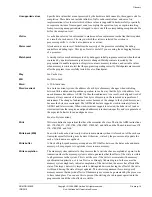
Glossary
ARM DDI 0363E
Copyright © 2009 ARM Limited. All rights reserved.
Glossary-13
ID013010
Non-Confidential, Unrestricted Access
Stride
The stride field, FPSCR[21:20], specifies the increment applied to register addresses in short
vector operations. A stride of 00, specifying an increment of +1, causes a short vector operation
to increment each vector register by +1 for each iteration, while a stride of 11 specifies an
increment of +2.
Subnormal value
A value in the range (–2
Emin
< x < 2
Emin
), except for 0. In the IEEE 754 standard format for
single-precision and double-precision operands, a subnormal value has a zero exponent and a
nonzero fraction field. The IEEE 754 standard requires that the generation and manipulation of
subnormal operands be performed with the same precision as normal operands.
Support code
Software that must be used to complement the hardware to provide compatibility with the IEEE
754 standard. The support code has a library of routines that performs supported functions, such
as divide with unsupported inputs or inputs that might generate an exception, and as well as
operations beyond the scope of the hardware. The support code has a set of exception handlers
to process exceptional conditions in compliance with the IEEE 754 standard.
Synchronization primitive
The memory synchronization primitive instructions are those instructions that are used to ensure
memory synchronization. That is, the
LDREX
,
STREX
,
SWP
, and
SWPB
instructions.
Tag
The upper portion of a block address used to identify a cache line within a cache. The block
address from the CPU is compared with each tag in a set in parallel to determine if the
corresponding line is in the cache. If it is, it is said to be a cache hit and the line can be fetched
from cache. If the block address does not correspond to any of the tags, it is said to be a cache
miss and the line must be fetched from the next level of memory.
See also
Cache terminology diagram on the last page of this glossary.
TAP
See
Debug test access port.
Thumb state
A processor that is executing Thumb (16-bit and 32-bit) instructions is operating in Thumb
state.
Tightly coupled memory (TCM)
An area of low latency memory that provides predictable instruction execution or data load
timing in cases where deterministic performance is required. TCMs are suited to holding:
•
critical routines (such as for interrupt handling)
•
scratchpad data
•
data types whose locality is not suited to caching
•
critical data structures (such as interrupt stacks).
Tiny
A nonzero result or value that is between the positive and negative minimum normal values for
the destination precision.
Trace port
A port on a device, such as a processor or ASIC, used to output trace information.
Trap
A exceptional condition that has the respective exception enable bit set in the FPSCR register.
The user trap handler is executed.
Unaligned
A data item stored at an address that is not divisible by the number of bytes that defines the data
size is said to be unaligned. For example, a word stored at an address that is not divisible by four.
Undefined
Indicates an instruction that generates an Undefined instruction trap. See the
ARM Architecture
Reference Manual
for more information on ARM exceptions.
UNP
See
Unpredictable.
Unpredictable
The result of an instruction or control register field value that cannot be relied upon.
Unpredictable instructions or results must not represent security holes, or halt or hang the
processor, or any parts of the system.



































